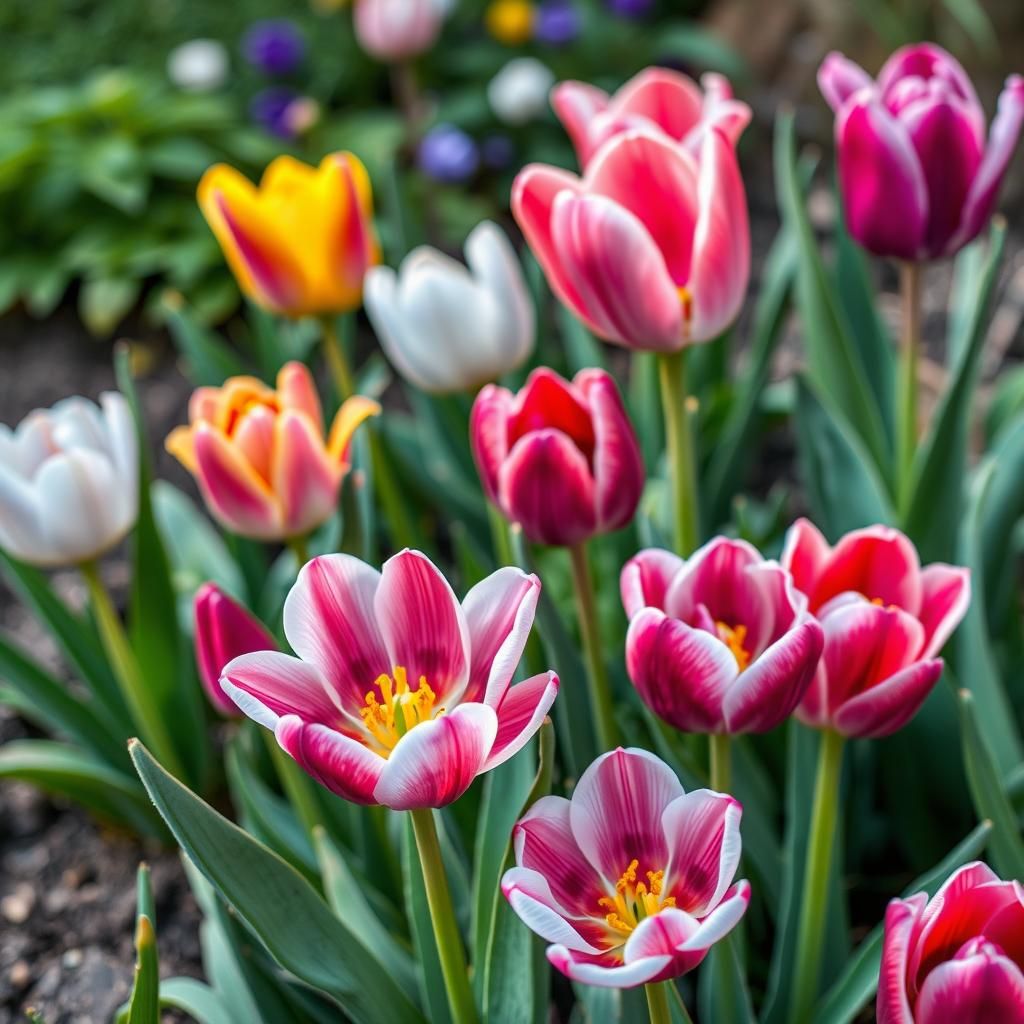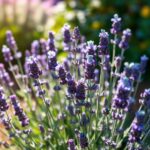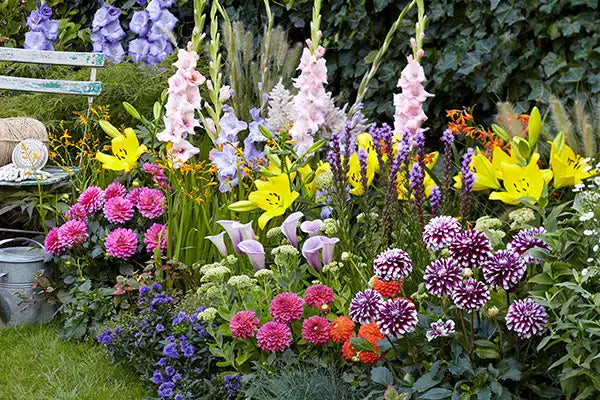Discover the Best Bulbs That Bloom in the Spring for a Colorful Garden

Spring is a season of renewal and vibrant colors, making it the perfect time to enhance your garden with blooming bulbs. With a wide variety of options available, choosing the right bulbs can transform your outdoor space into a stunning tapestry of color and life. From the cheerful daffodils to the elegant tulips, each bulb brings its unique charm and beauty. In this article, we will explore some of the best bulbs that thrive in spring, providing you with tips on planting, care, and companion planting, helping you create a colorful garden that will delight the senses and uplift your spirits.
- Spring-Blooming Bulbs: A Colorful Awakening
- What bulbs bloom in the spring?
- Daffodils
- Tulips
- Crocuses
- Hyacinths are renowned for their fragrant flowers and dense clusters. They are available in a variety of colors and are perfect for borders or containers. Fragrance: One of the standout features of hyacinths is their intense scent, which can fill a garden in spring. Soil Requirements: They thrive in rich, well-drained soil and full sunlight to encourage robust blooms. Post-Bloom Care: After flowering, cutting the flower stalk while allowing the foliage to continue growing is essential for the bulb's health. Alliums
- What are the earliest blooming bulbs in spring?
- Which spring bulbs bloom the longest?
- Are there any summer blooming bulbs?
- Questions from Our Readers
Spring-Blooming Bulbs: A Colorful Awakening
Spring-blooming bulbs are the heralds of the warming season, captivating garden enthusiasts with their vibrant colors and fragrance. As the frosty grip of winter loosens, these bulbs burst forth from the ground, showcasing their beauty and resiliency. Varieties such as daffodils, tulips, and hyacinths provide a stunning spectacle, transforming dull landscapes into gardens full of life and energy. Planting these bulbs in the fall ensures a spectacular display when spring arrives, as they gather the necessary nutrients to thrive in the warmer months ahead. Their unique structures and diverse color palettes make spring-blooming bulbs a must-have for any garden lover seeking to celebrate the season.
Popular Types of Spring-Blooming Bulbs
Spring-blooming bulbs come in numerous varieties, each offering unique features. Some of the most popular types include daffodils, known for their trumpet-like shape and bright yellow hues; tulips, cherished for their elegant form and vast color choices; and hyacinths, which are favored for their strong fragrance and dense flower clusters. Other notable mentions include crocuses, which often bloom first in the spring, and snowdrops, which bring a delicate touch with their small white flowers. Each type can add stunning visual interest to any garden or landscape.
Planting and Care Instructions
To ensure successful growth, it is vital to follow proper planting and care instructions for spring-blooming bulbs. Bulbs should typically be planted in the fall, allowing them time to establish roots before the ground freezes. The ideal depth for planting usually ranges from three to six inches, depending on the bulb type. It is essential to choose a well-draining location with plenty of sunlight, as most spring-blooming bulbs thrive in bright conditions. Regular watering while the foliage is green helps nourish the bulbs, ensuring vibrant blooms the following spring.
Companion Planting with Bulbs
Companion planting can enhance the aesthetic and ecological value of gardens featuring spring-blooming bulbs. Pairing bulbs like tulips with perennials such as daylilies or asters can create dynamic displays, with the bulbs providing early-season color and the perennials filling in the landscape later on. Additionally, planting spring bulbs alongside ground covers like creeping thyme can help suppress weeds and add texture to the garden. Thoughtful combinations not only create beautiful visual effects but also support biodiversity.
Common Pests and Diseases
Like all plants, spring-blooming bulbs are susceptible to certain pests and diseases. Common pests include bulb flies and nematodes, which can damage the bulbs during their growing season. Fungal infections such as botrytis or bulb rot can also threaten the health of your bulbs if conditions are overly wet. To minimize risks, ensure good drainage, avoid overhead watering, and consider using organic pesticides as a preventative measure. Regular monitoring and early intervention can keep your bulbs healthy and flourishing.
Benefits of Growing Spring-Blooming Bulbs
Growing spring-blooming bulbs has numerous benefits, both aesthetic and environmental. Visually, they provide a burst of color and life, marking the transition from winter to spring in gardens and public spaces. Environmentally, these bulbs can attract pollinators such as bees and butterflies, which are crucial for pollination and sustaining plant diversity. Additionally, many bulbs are low-maintenance once established, making them a great choice for busy gardeners or those new to gardening. Incorporating spring-blooming bulbs into a garden can lead to an enriching and rewarding experience.
| Bulb Type | Color | Fragrance | Bloom Time |
|---|---|---|---|
| Daffodil | Yellow | Light | March-April |
| Tulip | Various | Moderate | April-May |
| Hyacinth | Pink, Blue, Purple | Strong | March-April |
| Crocus | Purple, Yellow | Light | February-March |
| Snowdrop | White | None | January-February |
What bulbs bloom in the spring?

Spring is a vibrant season, marked by the blooming of various bulbs that have been dormant through the winter. Below are some of the most popular bulbs that bloom in spring.
Daffodils
Daffodils, with their bright yellow and white flowers, are among the first to bloom in spring. These hardy bulbs are known for their ability to thrive in various climates and are often planted in large groups for a stunning display.
- Planting Time: Daffodils should be planted in the fall, about 6 to 8 weeks before the ground freezes.
- Care Tips: They prefer well-drained soil and full sun or partial shade, requiring minimal maintenance once established.
- Symbolism: In many cultures, daffodils symbolize renewal and the arrival of spring.
Tulips
Tulips are a classic spring flower that come in nearly every color imaginable, making them a favorite among gardeners. They have a distinctive cup shape and bloom in various heights and sizes.
- Variety Selection: There are numerous varieties of tulips, including triumph, parrot, and fringed types, allowing for diverse garden designs.
- Planting Depth: Tulips should be planted at a depth of about 6 to 8 inches for optimal growth.
- Maintenance: After blooming, it's important to let the leaves yellow and die back before cutting them down to ensure energy goes back into the bulb.
Crocuses
Crocuses are some of the earliest bloomers in spring, often peeking through the snow. They are small, yet prolific, coming in shades of purple, yellow, and white.
- Ideal Conditions: Crocuses prefer well-drained soil and can tolerate some shade, making them great for naturalizing in lawns or wooded areas.
- Planting Tips: These bulbs can be planted in clusters to create a more striking visual impact.
- Pest Resistance: Crocuses are generally resistant to pests and deer, making them easier to maintain.
Hyacinths are renowned for their fragrant flowers and dense clusters. They are available in a variety of colors and are perfect for borders or containers.
See also:
- Fragrance: One of the standout features of hyacinths is their intense scent, which can fill a garden in spring.
- Soil Requirements: They thrive in rich, well-drained soil and full sunlight to encourage robust blooms.
- Post-Bloom Care: After flowering, cutting the flower stalk while allowing the foliage to continue growing is essential for the bulb's health.
Alliums
Alliums are striking with their spherical clusters of flowers, often seen in shades of purple and white. They provide unique architectural interest to spring gardens.
- Height Variation: Alliums come in various heights, from short to tall, allowing for versatile garden planning.
- Planting Depth: These bulbs should be planted at a depth of about 6 to 8 inches, similar to tulips.
- Attracting Pollinators: Alliums are known to attract bees and butterflies, making them beneficial for pollinator gardens.
What are the earliest blooming bulbs in spring?

The earliest blooming bulbs in spring are the flowers that emerge from their dormant state as winter recedes, bringing vibrant colors and a touch of life back to gardens and landscapes. Among these, several species stand out due to their ability to bloom early in the season. Here are some of the earliest blooming bulbs:
Snowdrop (Galanthus nivalis)
Snowdrops are among the first flowers to appear, often pushing through the snow. With their delicate, white, drooping flowers, they signify the end of winter. These bulbs thrive in moist, well-drained soil and prefer partial to full shade.
- Beloved for their resilience in cold weather.
- Can naturalize and spread over time.
- Often associated with early springtime joy.
Winter Aconite (Eranthis hyemalis)
The winter aconite can often be seen poking through the frost, featuring bright yellow flowers that add a cheerful touch to the still-bare landscape. These bulbs prefer rich, well-drained soil and can thrive in both sun and semi-shade areas.
- Attracts pollinators like bees after winter.
- Forms lovely, carpet-like colonies.
- Requires minimal care once established.
Hyacinth (Hyacinthus orientalis)
Hyacinths are known for their fragrant, dense flower clusters that bloom in various colors, including blues, pinks, and purples. They are typically one of the first bulb flowers to show in spring, often blooming shortly after the snowdrops and aconites.
- Thrives in full sun to partial shade.
- Prefers well-draining soil to prevent bulb rot.
- Ideal for containers and garden beds.
Crocus (Crocus spp.)
Crocuses are famous for their vibrant and colorful blooms that open with the warmth of the sun. These hardy bulbs appear in shades of purple, yellow, and white, often emerging right after the last frost.
- Can bloom even while snow is present.
- Naturalizes easily in lawns and gardens.
- Pollen serves as an early food source for bees.
Daffodil (Narcissus spp.)
Daffodils are iconic spring blooms, recognized for their bright yellow and white flowers. They are among the earliest blooming bulbs, often flowering as early as late February in mild climates.
- Usually thrive in a variety of soil types.
- Highly deer-resistant and pest-free.
- Come back year after year with minimal care.
Which spring bulbs bloom the longest?

The spring bulbs that bloom the longest typically provide an extended period of colorful flowers in the garden. Among various spring bulbs, daffodils, tulips, and hyacinths are known for their relatively long blooming periods, which can last from several weeks to a couple of months depending on the climate and specific variety.
Daffodils
Daffodils are one of the most popular spring bulbs due to their vibrant yellow and white flowers, which can bloom for up to six weeks. These hardy bulbs are known for being resistant to pests and deer, making them a reliable choice for gardens.
- Blooming typically starts in late March and can extend into May.
- Different varieties such as the King Alfred and Tête-à-tête can vary in bloom time.
- They thrive in well-drained soil and prefer full sun to partial shade.
Tulips
Tulips come in a wide variety of colors and shapes, blooming for about 1 to 2 months. The blooming period can vary based on when they are planted and the specific type of tulip chosen.
- Early blooming varieties may start flowering in April, while late varieties can bloom into May.
- Species tulips such as Tulipa tarda have longer blooming times and can naturalize, returning year after year.
- Tulips prefer well-drained soil and full sunlight for optimal growth.
Hyacinths
Hyacinths are known for their fragrant blooms and typically bloom for 2 to 3 weeks, which is relatively shorter than daffodils and tulips. However, they can be planted alongside longer-blooming bulbs to extend the overall flowering season.
See also:
- They often bloom in early spring, around late March to early April.
- Hyacinths thrive in sunny locations with well-drained soil.
- They are available in a variety of colors and can provide a strong scent to your garden.
Grape Hyacinths
Grape hyacinths (Muscari) are small, grape-like clusters that bloom for about 3 to 4 weeks in spring. They are excellent for naturalizing and create a beautiful carpet of color in gardens.
- They bloom from mid-April to May, contributing to the garden’s spring display.
- These bulbs are very hardy and can thrive in almost any soil condition.
- Grape hyacinths often spread easily, making them a low-maintenance option.
Snowdrops
Snowdrops are among the first signs of spring, often blooming as early as late winter and lasting into early spring. They usually bloom for about 2 to 3 weeks.
- These delicate white flowers can withstand some frost, blooming around late January to February.
- They prefer to grow in clumps, multiplying over time for a greater visual impact.
- Snowdrops thrive in moist, well-drained soil and partial to full shade.
Are there any summer blooming bulbs?

Yes, there are several summer blooming bulbs that can bring vibrant colors and beautiful flowers to your garden. These bulbs typically need to be planted in spring, allowing them to establish roots and flourish during the warmer months. Here are some popular options:
Types of Summer Blooming Bulbs
Summer blooming bulbs come in various species, each with unique characteristics and bloom patterns. Popular bulbs include:
- Lilium (Lilies) - Known for their large, fragrant flowers, lilies bloom in various colors and sizes.
- Dahlia - These bulbs produce stunning, bushy flowers that are perfect for cut arrangements and come in many shapes and colors.
- Gladiolus - Featuring tall spikes covered with tubular flowers, these bulbs are great for adding height to garden displays.
Growing Conditions for Summer Blooming Bulbs
To ensure that summer blooming bulbs thrive, they require specific growing conditions. These include:
- Well-drained soil - Bulbs must be planted in soil that drains well to prevent rot.
- Full sun - Most summer blooming bulbs perform best when given at least six hours of sunlight each day.
- Consistent moisture - While bulbs need to be watered regularly, overwatering should be avoided.
Care and Maintenance of Summer Blooming Bulbs
Proper care and maintenance are essential for the health and beauty of summer blooming bulbs. Consider the following tips:
- Fertilization - Use a balanced fertilizer to promote growth during the flowering season.
- Deadheading - Remove spent flowers to encourage further blooming and maintain plant health.
- Staking - Taller varieties may need staking to prevent them from toppling over due to their height.
Popular Varieties of Summer Blooming Bulbs
Some varieties of summer blooming bulbs are particularly favored among gardeners for their robust nature and stunning appearance. Examples include:
- Tuberous Begonias - Ideal for shaded areas, producing large, colorful blooms.
- Calla Lilies - These elegant flowers are known for their unique shape and vibrant hues.
- Ranunculus - With their layered petals, they add a romantic touch to any garden setting.
When to Plant Summer Blooming Bulbs
Timing can be crucial when it comes to planting summer blooming bulbs. The ideal periods include:
- Spring planting - Most bulbs should be planted in early spring once the soil has warmed up.
- Timing for specific bulbs - Some may require a little earlier or later planting; it is important to check species-specific information.
- After frost - Ensure there's no risk of frost before planting to protect the bulbs.
Questions from Our Readers
What are some popular bulbs that bloom in the spring?
Spring bulbs that are widely beloved include tulips, daffodils, and hyacinths. These flowers not only bring vibrant colors to gardens but also signify the arrival of spring, making them a favorite among gardeners. Tulips are available in various hues, while daffodils are celebrated for their cheerful, trumpet-like flowers.
When should I plant spring-blooming bulbs?
For optimal growth, spring-blooming bulbs should be planted in the fall, ideally about six weeks before the first hard frost. This timing allows the bulbs to establish roots in the cooler soil, enabling them to bloom beautifully when spring arrives. Proper planting ensures a healthy start and vibrant flowers as the season progresses.
How do I care for spring-blooming bulbs?
Caring for spring-blooming bulbs involves regular watering, especially during dry spells, and ensuring they receive adequate sunlight. Once they bloom, it is essential to deadhead the flowers to encourage better growth for the following year and to allow the foliage to remain until it yellows, helping the bulbs store energy for the next cycle.
Can I force spring bulbs to bloom indoors?
Yes, many types of spring bulbs can be forced to bloom indoors, which is often done using a technique called forcing. This method typically involves chilling the bulbs for several weeks, then planting them in pots with soil and providing the right conditions of light and moisture to stimulate growth. Forcing can result in beautiful early blooms, bringing the essence of spring into your home even in colder months.
https://youtube.com/watch?v=NU7Ds3Dfe_w

If you want to read more articles like Discover the Best Bulbs That Bloom in the Spring for a Colorful Garden, we recommend you check out our Landscaping category.
Leave a Reply
Related Articles